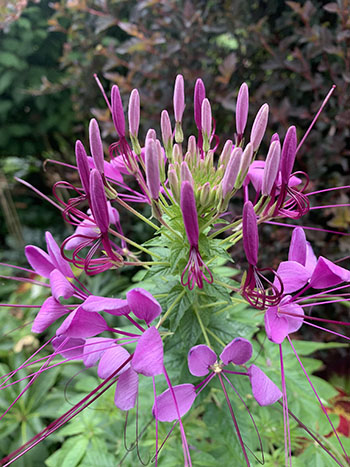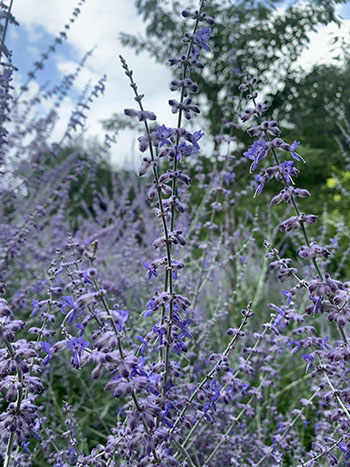Guest Author: Summer Intern Mildred Arevalo

Cleome hassleriana ‘Violet Queen’, more commonly known as the spider flower is native to South America, and now is proudly displayed in the Scott Entrance Garden. This species’ common name references its identifying features like the long stamens that spill out from the center of its 4 short rounded petals. It was impossible to miss the spider flower’s dramatic blooms when I first walked past, bursting at the seams with petals and stamens flying radially in all directions. The spider flower’s intricate but imposing presence would be a great ornamental addition to your garden! Don’t be fooled by its delicate presence, ‘Violet Queen’ earned its name with its hardy drought resistant and sun loving reputation as well as efficient sowing of seeds. photo credit: M. Arevalo

The Iris domestica is a regal six-petaled flower with rouge dots scattering the orange petals. Located once more in our Scott Entrance Garden, this perennial goes by blackberry lily and can be grown in full sun or light shade. However, the blackberry lily packs a few surprises. Formally known as the Belamcanda chinensis, it produces a unique cluster of inedible berries that split into pods when it seeds, a bloom that only lasts one day, and a DNA sequence that surprised scientists as well, shifting its taxonomic classification to the genus Iris. Blackberry lily can tolerate several soil types such as rich, sandy, and clay like. This plant blooms in mid to late summer and reaches up to 2- to 3- feet tall. You should consider planting this flower in your garden this summer for its colorful flowers, ability to self-sow, and attract all kinds of great pollinators. photo credit: M. Arevalo

Salvia yangii (syn. Perovskia atriplicifolia) also known as Russian sage, is a perennial native to Central Asia (such as Afghanistan and Pakistan), Southwest Asia and Western Europe. This variety has a beautiful dusty green square stem that hints to its belonging in the family of Lamiaceae and grows 3-4 feet tall with a wide bush base. Russian sage is a favorite of xeriscaping landscapers with its nuanced purples that gracefully pair with other desert plants like sneezeweed, echinacea, and pastel colored gardens while bravely tolerating drought seasons. Overwhelmed by its purple flowers, Russian sage similarly overpowers its surroundings with its fragrant presence, attracting pollinators left and right. Again in our Scott Entrance Garden, I hope you can come and enjoy the thick scent of Russian sage as much as I do during my morning walks into the Arboretum. photo credit: M. Arevalo
